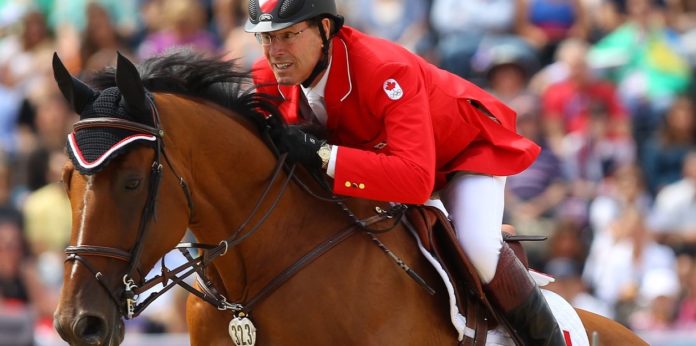By Shelley McLean
Two-time winner of the Show Jumping World Cup and Olympic equestrian silver medalist Ian Millar knows his way around horses. His long and storied career even led to his nickname, Captain Canada. But after a rare accident on his farm in Perth, he was rushed to The Ottawa Hospital Trauma Centre with a severe arm injury. Ian was quickly losing blood, causing deep concern for his life.
In late October 2020, Ian was riding a young mare when something startled her. She reared up on her hind legs, and then came down hard and spun around, causing Ian to be tossed over her head and onto the ground.
“I was sailing through the air; I knew exactly what I was going to do in terms of landing to make sure there was no damage. Normally, the horse will do what it can to avoid stepping on you, but this one came down on me three times,” says Ian.
Significant blood loss
The 74-year-old could feel pain through his ribs and one leg. However, the real concern was the damage to his left arm, just above the elbow.
“I tried to get up but the bleeding was significant. The wound was about eight inches in length and I could see the nerves and muscles. My main barn guy, who has medical training, rushed to help, along with my family. They thought I was in big trouble because of the amount of blood I was losing.”
A tourniquet was quickly created to stop the bleeding while a call went out to 9-1-1 for help. Within minutes, paramedics arrived and whisked him to a nearby community hospital, where the helicopter was waiting to fly him to The Ottawa Hospital Trauma Centre.
Ian says an exceptional team awaited him. “They were beyond words. I want to say there were about six team members there when I arrived and they were ready to rock and roll.”
Trauma Centre serving eastern Ontario
With the uncertainty over the extent of damage to Ian’s arm, he would need the most advanced treatment options available. The Ottawa Hospital has the only Level 1 Trauma Centre in eastern Ontario — this is where the most critically-injured patients from across the region, including Québec in some cases, come for lifesaving care, often bypassing smaller community hospitals.
Today, when patients like Ian arrive by air ambulance to the Civic Campus, they need to be rushed across a busy street from the helipad to the hospital. All that will change when the new Civic development is complete in 2028. This new hospital campus will save crucial time with dedicated high-speed elevators that will bring critically-ill and severely-injured patients directly from the rooftop helipad to a trauma bay.
Specialized teams ready
When Ian arrived, Dr. Edmund Kwok, an Emergency Department (ED) physician and Director of Quality Improvement Unit for the ED, was waiting. He still vividly remembers that day.
“It was the beginning of my shift. I had just walked into the resuscitation bay when we received the call that an ORNGE air ambulance was on the way, and there was the risk of the life-threatening arterial bleed.” With that call, Dr. Kwok and his team prepared the trauma bay for the patient’s arrival.
Ian was conscious and stable, but the main concern remained his arm.
“Arterial injuries can bleed out very quickly. Therefore, it is a potentially life-threatening situation. It’s like plumbing. When we release the pressure it has to be done in a very controlled manner,” explains Dr. Kwok.
Expert team collaboration
Once they removed the tourniquet, Ian started to bleed out.
“We put a call out to vascular, orthopaedic, and plastic surgeons. We needed these specialists involved and their response was prompt. We had the vascular team at the bedside before Ian’s imaging was completed.”
Ultimately, the vascular physician determined it was not an arterial bleed and repaired the damage to the veins before handing it off to the plastic surgeon to close the wound.
“This is a classic example of an injury which involved different specialists. Vascular and plastic surgeons provide highly specialized services and to have them all in one location and able to respond promptly made a huge difference in this patient’s outcome because the tourniquet couldn’t have been left on for much longer.”
Going home six hours later
Remarkably, Ian went home about six hours after he was rushed into hospital. Even more amazing, there were no broken bones—only a dislocated rib and a superficial leg wound. For Ian, it was an eye-opening experience.
“Before this, I didn’t know the Civic Campus was the only Trauma Centre in our region. The care I received was unbelievable. We’re fortunate to have that team of experts ready for any injury. It seemed to me every specialty was waiting and ready to help.”
The Olympian was back riding within a couple of weeks with full use of his arm. And for that, he’s grateful for the team that cared for him.
“They were a well-oiled machine,” he says. “It made me proud to be a Canadian.”
Shelley McLean is a Senior Marketing Officer for The Ottawa Hospital Foundation.


